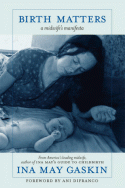January 20, 2012 7 Stories Press

From the Sun Magazine’s front page interview:
Ina May Gaskin is sometimes referred to as the “midwife of modern midwifery” because of the role she’s played in the rebirth of that profession in the United States.
Midwives, who are trained to assist with pregnancy, labor, and postpartum care, were once common in this country, but the profession was virtually eliminated in the early twentieth century and replaced by obstetrics. When Gaskin began performing midwife duties in the early 1970s, only a handful of U.S. hospitals employed nurse-midwives as birth attendants. Today about 10 percent of births are attended by midwives — either certified nurse-midwives, who mainly work in hospitals and birth centers, or certified professional midwives, like Gaskin, who attend births in homes or birth centers.
Gaskin practices at the Farm Midwifery Center in southern Tennessee. The Farm, an intentional cooperative community, was established in 1971 by Ina May’s husband, Stephen Gaskin, who had come to fame in San Francisco in the late sixties through his weekly lectures on spirituality and social-justice issues, called “Monday Night Class.” In 1970 he went on the road for a lecture tour and allowed more than two hundred young people to accompany him in a caravan of school buses and trucks converted into campers. Nine births took place in the caravan, with Ina May acting as midwife — since she was, at thirty, older than most of them, and a mother. A Rhode Island obstetrician provided her and some of the other women with a seminar in emergency childbirth measures, an obstetrics handbook, and supplies. Once the lecture tour had ended, most of the group pooled their money to buy land in Tennessee and start the Farm.
Gaskin soon accepted the role as her vocation and, with her friend and midwife partner Pamela Hunt, began to study natural childbirth. They got their training on the job, with some help from mentor physicians who had experience assisting in home births for a large Old Order Amish community in the area. Meanwhile the Farm was reaching out to the rest of the world through its burgeoning aid organization Plenty. In 1976 an earthquake struck Guatemala, killing more than twenty thousand people and leaving a million more homeless. Plenty volunteers traveled there to help, and Ina May made contact with the local midwives. From them she learned a procedure for dealing with a birth complication known as “shoulder dystocia.” She brought this lifesaving knowledge back to the U.S., where it became known as the “Gaskin maneuver,” the first obstetrical maneuver to be named after a midwife. She believes that midwives in the developing world possess wisdom and practical skills worthy of being studied in more-affluent countries.
The Farm has undergone many changes in its forty-year history, but the midwifery center has been a mainstay, providing prenatal care, doula services (nonmedical assistance and support for women in labor), birthing facilities, in-hospital services, postpartum care, and health education for women. The Center is known for low rates of medical intervention, morbidity (illness or injury associated with pregnancy and childbirth), and mortality and has become a touchstone of how safe birth can be.
Gaskin is the author of four books on natural childbirth. Her most recent, Birth Matters: A Midwife’s Manifesta, focuses on the sharp rise in cesarean births, or c-sections, in the U.S. and the corresponding rise in the percentage of women who die from birth-related causes, referred to as the “maternal mortality rate.” To draw attention to the increase in maternal mortality over the last two decades, Gaskin began the Safe Motherhood Quilt Project (www.rememberthemothers.org). Like the aids quilt, it’s a collection of hand-sewn memorials, in this case honoring women who have died of pregnancy-related causes during the past thirty years.
For twenty-two years Gaskin published a quarterly titled Birth Gazette. She was president of Midwives Alliance of North America from 1996 to 2002, and a former director at the World Health Organization called Gaskin the “most important person in maternity care in North America.” In 2011 she was a recipient of the Right Livelihood Award, also known as the “alternative Nobel prize.” She travels widely to lecture on the Gaskin maneuver and other matters pertaining to childbirth. Her message, at home and abroad, is that the most important “technology” for a woman in labor is patience, kindness, and encouragement.
I traveled to the Farm on a hot day in mid-July and sat down with Gaskin at her dining-room table in the comfortable, book-cluttered house she shares with Stephen. Two filmmakers were there making a documentary about her, and they set up their cameras to film part of the interview. Stephen stood in the kitchen, tall and thin, with a long white ponytail and a beatific smile. “People ask me if it bothers me now that Ina May is more famous than I am,” he said as he handed me a glass of water. “I answer, No! I am happy she is keeping our light lit on the international board.”
After we’d talked for an hour, a thunderstorm broke, and we made a dash for our vehicles and drove down to the clinic. The documentarians filmed Gaskin as she talked with Kristina, a young woman who was due to deliver any day, and her husband, Seth. The walls were decorated with pictures of wise-eyed babies, and the atmosphere was one of cheerful anticipation.
MacEnulty: One of my friends told me that when he and his wife decided to have a home birth, he was roundly criticized by family members, who said he was being irresponsible and endangering the health of the baby.
Gaskin: There is an assumption that we humans are inferior to the other five thousand or so species of mammals in our ability to give birth to our young. I have always found it hard to accept this notion, probably because my father was a farmer for years. Those who are used to the birth ways of other mammals know that it is easy to cause complications during labor by disturbing the mother. If we put horses, goats, and cows through the restrictions and indignities that most laboring women in U.S. hospitals are routinely subjected to, the animals would surely have as many complications as we do. The astonishing thing to me is that we have come to believe that our human bodies are not as well designed for birth as other mammals’ are. Really it’s our brains that can pose problems: we alone among mammals have the ability to scare and confuse ourselves about birth.
MacEnulty: How did you become an advocate for midwives and natural childbirth? Weren’t you an English major?
Gaskin: Yes, and after I got my master’s degree, I joined the Peace Corps. But I was always interested in birth and birth stories. I had a horrific hospital birth — a mandatory and unnecessary forceps delivery — in the 1960s, and I knew there had to be a better way. Eventually I began hearing stories of natural birth, and they sounded beautiful and very different from the experience I’d had in the hospital. I set out to learn about it, and it became a calling.
MacEnulty: Your earlier books — Spiritual Midwifery, Ina May’s Guide to Childbirth, and Ina May’s Guide to Breastfeeding — could be characterized as how-to manuals, but your new book, Birth Matters, is subtitled A Midwife’s Manifesta. Why the urgency?
Gaskin: The urgency arises from the fact that we in the U.S. are in danger of destroying both obstetrics and midwifery in favor of all births being surgical operations. We know from the example of private hospitals in Brazil how far this trend can go — many of those hospitals have c-section rates that exceed 95 percent. It’s important to realize that Brazil has a relatively high maternal death rate — higher than ours. If we’re going to imitate any country’s maternity care, we should copy a country with better outcomes than ours.
My partners and I — and countless other midwives — know that, under the right circumstances, births can be safely handled with a minimum of c-sections. We have been able to attend some three thousand births, including breech [when the baby enters the birth canal buttocks first] and twin births, over the last forty years, and our c-section rate is 1.7 percent. There were only two c-sections in our first four hundred births. If these statistics are possible for us, they are possible for others. To accomplish this, we had to make sure that pregnant women had good nutrition and a healthy amount of exercise, and we needed to do everything we could to reduce the amount of fear surrounding birth by demystifying the process. All of these measures together have made the good outcomes at the Farm Midwifery Center possible.
MacEnulty: But aren’t there times when a c-section is the safest option for a woman — for example, a woman with small hips and a ten-pound baby?
Gaskin: Of course there are situations when a c-section is necessary. It may be that the baby gets into a poor position, or, rarely, the placenta might start to detach from the uterus before the baby is born or plant itself right over the cervix. The latter complication happens more often in women who have had previous c-sections.
But my partners and I have found that c-sections are very rarely necessary because of a mismatch in size between the woman and her baby. Having helped a number of women with what appear outwardly to be small hips give birth vaginally to ten-pound babies, I know that appearances can be deceiving. I have encountered fewer than ten cases out of three thousand in which the baby was actually too large to fit through the maternal pelvis. It happens most often with diabetic women, whose babies can sometimes weigh more than twelve pounds.
MacEnulty: What percentage of pregnant women currently give birth by c-section in the U.S.?
Gaskin: Approximately 34 percent. In many hospitals the rates of induction [starting labor through medical intervention] are in the range of 70 to 90 percent. Given the increasing maternal and neonatal death rates here, it’s imperative that we make efforts to reexamine these practices. We shouldn’t be routinely applying extreme technologies to birth without a good system for monitoring the effects.
The U.S. maternal death rate steadily decreased between 1936 and 1982. At that point it leveled off for a few years and then began rising. Women today actually face twice the chance that their mothers did of dying from pregnancy-related causes. We should be studying what’s behind this backward trend, especially since it is not happening in other developed countries. And, I must add, there simply aren’t enough planned home births — about twenty-eight thousand births per year out of a total of 4.2 million — to account for this unacceptable increase. Though home births increased 20 percent between 2004 and 2008, still less than 1 percent of all U.S. births are planned home births. But that doesn’t stop some in the medical profession from trying to use midwives as scapegoats for shortcomings in our country’s system.
Several studies have appeared in the U.S. obstetrical literature over the last thirty years that manipulate statistics to claim that home birth is dangerous for babies. Many well-designed studies from different countries, including ours, have shown the opposite results — that planned home births are quite safe for mothers and babies and manage to produce good outcomes with low rates of medical intervention or transfer to a hospital.
MacEnulty: Are there other potential reasons the U.S. maternal death rate is rising? Inadequate prenatal care? Obesity?
Gaskin: Amnesty International investigated whether lack of access to timely prenatal care played a significant part in the rising death rate and found a lot of evidence to confirm this. Assisted reproductive technologies have increased the number of multiple pregnancies, and it’s well documented that we have more diabetic women becoming pregnant than ever before. However, until we create a well-designed system for ascertaining the cause of every maternal death — something that most affluent countries did when they began providing health coverage for all their people — we’ll have to continue guessing how big a role obesity, assisted reproductive technologies, medical errors, and older maternal age play in making childbirth more dangerous.
MacEnulty: Aren’t more and more hospitals making their birth environments more mother-friendly and encouraging the use of midwives and doulas?
Gaskin: There are some wonderful hospitals that are doing everything they can to implement mother-friendly care, but the pace of these changes overall is quite slow. We still have plenty of hospitals that have never hired midwives even though we know well that midwives on staff help reduce c-section rates. The website www.theunnecesarean.com publishes the c-section rates at a growing number of hospitals across the country, so you can seek out the lowest ones. Too many hospitals give more attention to the way their facilities look than to making sure their maternity-care practices are based on strong scientific evidence. We can’t expect hospitals to change if they are not pressured to do so.
MacEnulty: What part do lawsuits — or the threat of them — play in the rising c-section rate?
Gaskin: They play a very big part and have since the late 1980s. Many obstetricians will tell you that they’re doing a lot of c-sections because of fear of lawsuits.
The initial quadrupling, from 5 percent to 20 percent, of the c-section rate between 1970 and 1980 happened in part because insurance companies issued ultimatums to hospitals that they were no longer to do — or teach — vaginal breech births. In a 1979 report commissioned by the U.S. government, a researcher pointed out that almost none of the respondents to the survey had actually been sued. Still, insurance companies decided that vaginal breech births weren’t safe. If doctors performed them, the insurer would cancel the malpractice insurance for the whole hospital. And the obstetrics community did not fight that ultimatum as it should have.
The malpractice lawsuit was invented in the U.S. because of the large number of uninsured people. The idea was that if a medical error created an expensive lifelong disability for someone who was uninsured, there needed to be some way of financing the future healthcare of that person. Now the tail is wagging the dog.
MacEnulty: Why did the insurance companies insist on c-sections if lawsuits were not really an issue?
Gaskin: When you have people who are not trained in critically reading the medical literature, they often can’t distinguish between good research and bad research, and they’ll go with whatever sounds scariest. One very unbalanced article published in 1959 by Dr. R.C. Wright helped fuel fears about vaginal breech births. Apparently his breech-delivery skills weren’t up to par. His article was the first to recommend that all breech babies be extracted via cesarean. By 2001 it was rare for a breech baby to be born vaginally anywhere in the U.S.
MacEnulty: Before c-section became so commonplace, how were breech births handled?
Gaskin: Almost all were born vaginally. It used to be that every obstetrician and family doctor who did obstetrics was required to know how to deliver breech babies. During the first few years that I worked as a midwife, the doctors at our local hospital were proud of their breech skills. I remember hearing about a twelve-pound baby who’d been born breech in good condition. Most academically trained midwives in the U.S., however, were not taught to deliver breech babies until recently. It was assumed that they would work in hospitals, where there would always be a doctor available to step in. As a result, the midwives who did know how to deal with breech birth were those who had a home-birth practice or had learned the skill in some impoverished area of the world. And after 1980 or so doctors themselves were no longer trained in breech deliveries. This put many women with undiagnosed breeches in unsafe hands when they arrived at the maternity ward: if their babies came too quickly, there might not be time to prepare for a c-section, but that would be the only option available to the doctor.
MacEnulty: How did you learn how to deliver a breech baby?
Gaskin: During our early years here at the Farm we had a mentor named John O. Williams Jr. He was one of two family doctors who provided medical and maternity services to the Old Order Amish community nearby. For the Amish, home birth has always been the norm, and they are good at it. The grandmothers did a lot of the deliveries. But when something was out of the ordinary, they would get in touch with Dr. Williams. The first time he went there for a breech birth, he explained that they would have to go to the hospital. The two grandmothers said, “Our doctor in Ontario always does breech births at home. You’re as good as he is, aren’t you?” That turned out to be his first, but not his last, home breech delivery.
At the beginning, whenever a baby was in breech position at the Farm, we would take the woman to the hospital, but the doctors there always did these big episiotomies [incisions to the perineum], which we knew weren’t necessary. One time they put the woman under general anesthesia, and then they had difficulty getting the labor going again. We felt that if we’d been with the woman, she would have stayed relaxed, and general anesthesia wouldn’t have been necessary. Eventually we had one breech baby that came too fast for us to get the mother to the hospital, and the baby literally fell into the midwife’s hands.
Breech birth can be difficult but usually isn’t if everyone is able to remain calm. The danger with breech babies is that it’s tempting to grab their feet and pull while panicked (exactly the wrong thing to do). Dr. Williams came for the first planned breech birth we performed. It wasn’t long before I was doing them while he watched. He also used to come out for twins when he could. That was how we saw our first footling breech.
MacEnulty: “Footling”?
Gaskin: That’s when the baby comes out feet first. In this case involving twins, baby number one came out fine, but baby number two was taking longer than Dr. Williams was comfortable with, so he just held the baby’s feet and gently guided him out.
MacEnulty: What can happen when doctors don’t know how to do vaginal breech births?
Gaskin: Doctors can become so afraid of assisting in a vaginal breech delivery that they might perform a c-section in a situation that is not as safe as it should be. In extreme cases the mother can even die. In New South Wales, Australia, for instance, there were three maternal deaths in 2010 stemming from elective c-section for breech presentations, and a 2007 Dutch study reported four such deaths within a three-year period. I know of two other maternal deaths that happened in the U.S. because of the mandatory c-section policy for breech babies. One of these women was a physician herself. The other was the mother of nine children, a Jehovah’s Witness, whose second twin was a footling breech after the vaginal birth of her first. She refused a blood transfusion because of her faith and bled to death during a c-section that would not have been performed twenty or thirty years ago. Her doctor was more worried about delivering the easiest footling breech possible — a second full-term twin — than about doing a c-section for a mother whose religious principles didn’t allow her to receive blood.
It’s actually insane that our obstetricians aren’t properly trained to deal with a situation that occurs in about 4 percent of all pregnancies at term, especially when most of the training could be accomplished with the use of mannequins and baby dolls and videos of breech births.
MacEnulty: The Jehovah’s Witness case seems like a rare occurrence. When women die as a result of c-section, what typically goes wrong?
Gaskin: Pulmonary embolism is one of the most frequent fatal complications. A blood clot in the leg dislodges and travels to the lungs. It can happen days or even weeks after a c-section, and often women and their family members aren’t warned of the signs and symptoms of this complication when they are discharged from the hospital. Hemorrhage, infection, and placental complications in a subsequent pregnancy are three other possible causes of maternal death after a c-section.
A vaginal birth has always been safer for the mother. The risk of death of the mother is three times greater for c-section than for vaginal birth. If we’re talking about emergency c-section only, this figure rises to four times greater. It’s a shame that any woman should lose her life because certain obstetrical skills are no longer taught.
Read the complete text in the print edition of Sun Magazine’s issue 433.



